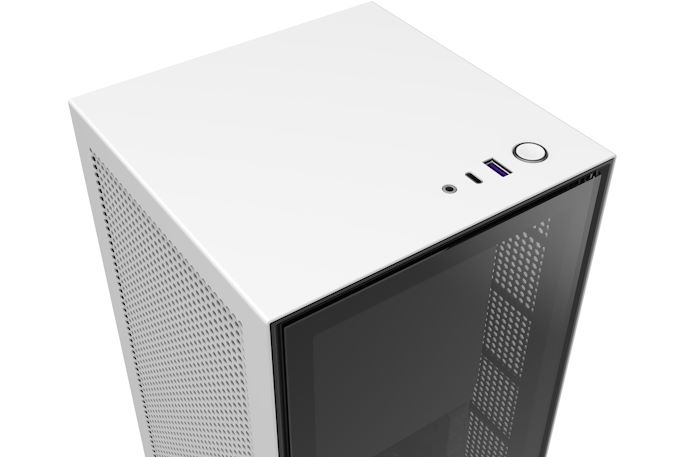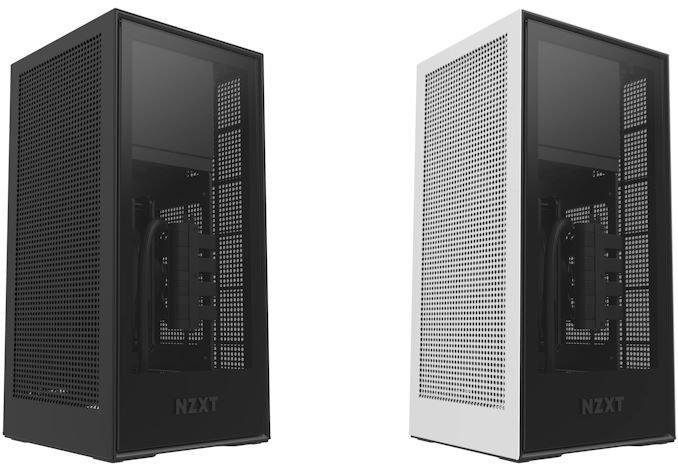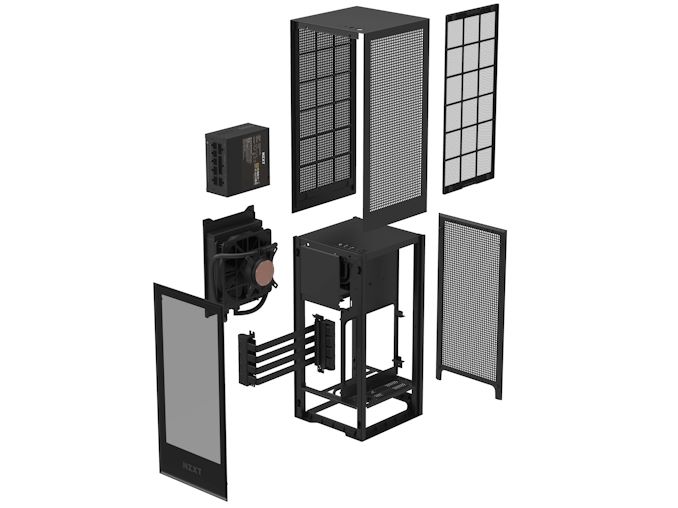NZXT Debuts H1 Mini-ITX Case for Big Gaming Rigs & NZXT BLD H1 Mini PC
by Anton Shilov on February 26, 2020 4:00 PM EST- Posted in
- Cases/Cooling/PSUs
- Mini ITX
- NZXT
- Cases

Small form-factor gaming PCs are on the rise these days, but because leading-edge components like CPUs and GPUs tend to produce a lot of heat and therefore require bulky cooling systems, it is not easy to build a truly compact PC with top-of-the-range components. Some makers of chassis attempt to design compact cases for gaming desktops, and this week NZXT introduced its Mini-ITX case for systems with leading-edge hardware. Alongside the Mini-ITX case, the company also unveiled its NZXT BLD H1 Mini PC that packs Intel’s Core i9-9900K and NVIDIA’s GeForce RTX 2070 Super.
The NZXT H1 Mini-ITX case is dual-chamber 13.6-liter vertical chassis made of stainless steel and tempered glass that can house a Mini-ITX motherboard, an up to 305-mm long 2.5-wide graphics card, and two 2.5-inch storage devices. The case measures 187 mm × 387.7 mm × 187.6 mm, which is a little bit larger than one comes to expect from a Mini-ITX chassis, but which is still considerably more compact than almost any Micro-ATX case. The chassis has air intakes on two sides out of four, to ensure proper cooling for the internal hardware.
NZXT’s H1 comes with a pre-installed 140-mm closed-loop CPU liquid cooling system, a PCIe 3.0 x16 riser card, filters on air intakes, and a 650 W SFX-L 80 Plus modular PSU. The upper panel has a USB Type-A and a USB Type-C connector as well as a 3.5-mm combo audio jack. As the case — set to be available in black or white — is stuffed by default with a PSU and a cooler, the product will retail for a higher $349 price.
In addition to the case itself, NZXT will offer its pre-built BLD H1 Mini PC that is based on Intel’s Core i9-9900K CPU as well as NVIDIA’s GeForce RTX 2070 Super Founder’s Edition graphics card. The system uses the ASUS ROG Strix Z390-I motherboard and is equipped with Team Group’s 16 GB of DDR4-3200 memory, and Intel’s 1 TB 660p SSD. The system costs $1,999.
Related Reading:
- NZXT Unveils Kraken X-3 and Kraken Z-3 Series Closed-Loop CPU Coolers
- NZXT Releases C-Series PSUs: 80Plus Gold and up to 850W, Built By Seasonic
- NZXT Refreshes H Series, New H510 Elite Chassis With RGB
- CES 2020: ASUS Unveils ROG Z11 Mini ITX Chassis For Gamers
- ASUS ROG Strix X570-I Gaming Mini-ITX Motherboard: Wi-Fi 6, Dual PCIe 4.0 M.2
- ZADAK Demonstrates MOAB: "World’s First Portable Water-Cooled PC"
Source: NZXT












32 Comments
View All Comments
J3EBS - Wednesday, February 26, 2020 - link
Why not go all the way and just say they should make them spherical?Because the internal components don't allow it, and as such there are other considerations besides Side A = Side B = Side C. I think sticking to a small footprint with a taller height is genius, because if fans are placed top and bottom that follows the natural air flow; ITX boards are 17cm x 17 cm and most higher end graphics cards are ~20-25 cm, so should every dimension of the case be sized to accommodate that?
Alistair - Wednesday, February 26, 2020 - link
... a cube is maximized volume in 3D, not a Sphere... hahaJ3EBS - Wednesday, February 26, 2020 - link
Yea, but a sphere is cheaper, less material! Why use more at all?Flunk - Wednesday, February 26, 2020 - link
That doesn't make sense because the hardware you put in the case is not cube-shaped. Video cards are much longer than they are wide or tall. ITX motherboards are pretty much square but not very tall.Alistair - Thursday, February 27, 2020 - link
that's why shorter video cards make sense, they are the same length as the motherboard, that is idealAlistair - Thursday, February 27, 2020 - link
video cards should be 6.7 inches long, just like itxthsrj - Thursday, February 27, 2020 - link
It's not about maximizing volume in the case, which seems to be the only metric for "efficiency" to you; It's about the density of components per liter. The typical DAN Case A4 layout run laps around your cube SFF cases space efficiency-wise, same for designs like the S4 mini, because guess what? Cube cases are 70% empty space, great for a box you stuff things into, not so much for a PC case.Valantar - Thursday, February 27, 2020 - link
Just to add that I agree with the others here: a cube is very inefficient shape for a PC case that is made to fit a motherboard, PSU and GPU. The two first ones can stack neatly into a small cube, but the GPU breaks that symmetry entirely unless you limit yourself to short ITX cards (but then you'll still have to stack the PSU atop the motherboard, blocking CPU airflow). The M1 and A4 clearly demonstrated that the "shoebox" form factor is the most space efficient for standard components.As for claiming a case 175% the volume of this is "just as small"... well, we're all entitled to our opinions, no matter how silly. That case will take up twice the amount of desk space for no actual benefit. And the difference when sitting close to it will be very, very obvious.
sharath.naik - Thursday, February 27, 2020 - link
LOUQE Ghost S1 at 8L and extendable to support multiple configurations for AIO. is simply a better case. Still equally expensive.https://www.amazon.com/LOUQE-Ghost-S1-Ash/dp/B07FS...
nerd1 - Friday, February 28, 2020 - link
It costs $320 with top hat, and does not come with AIO cooler nor PSU, which costs like ~$250 extra. So it costs almost double the price of this.That said I own one, and the cnc made parts are really nice.